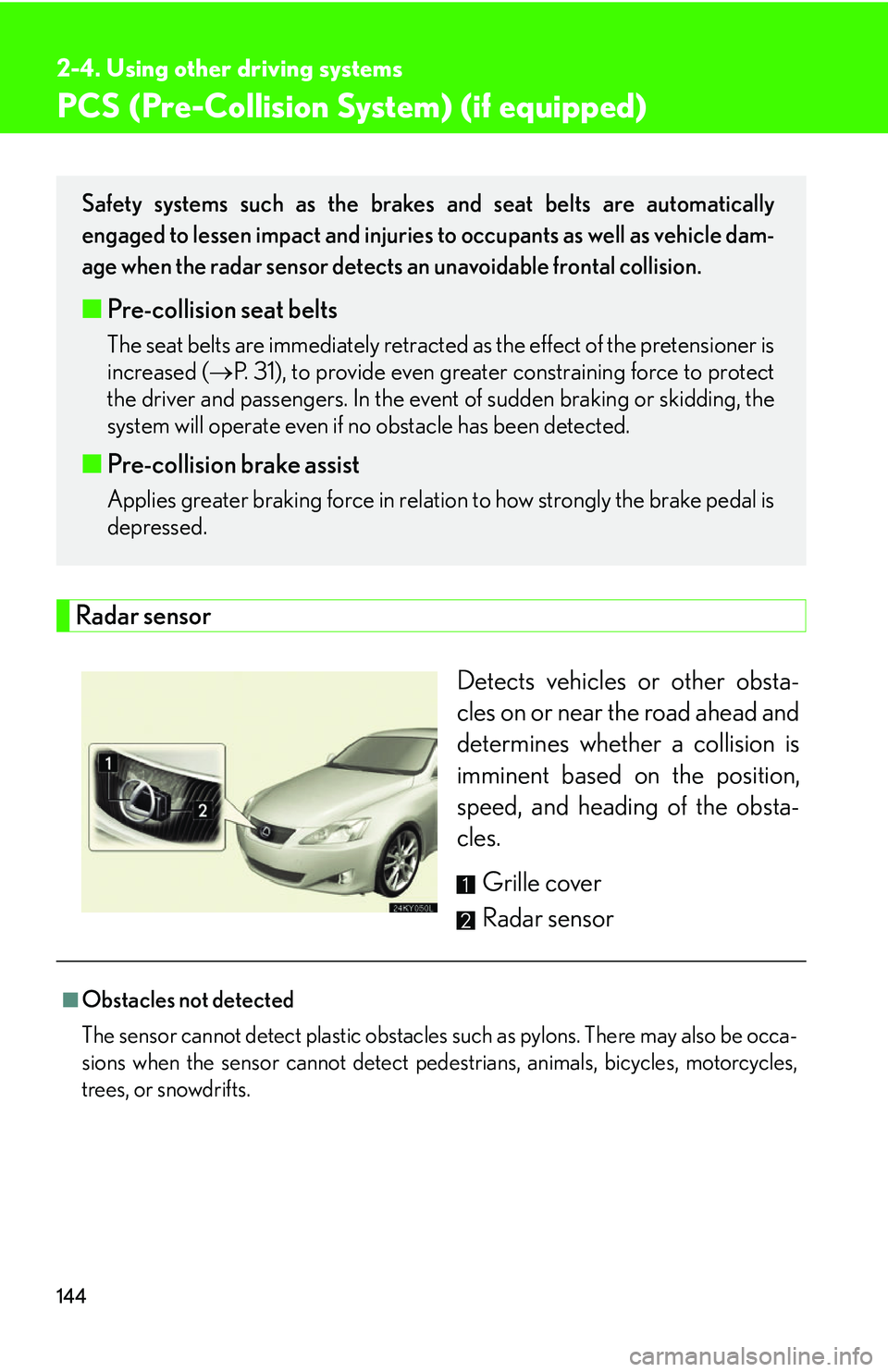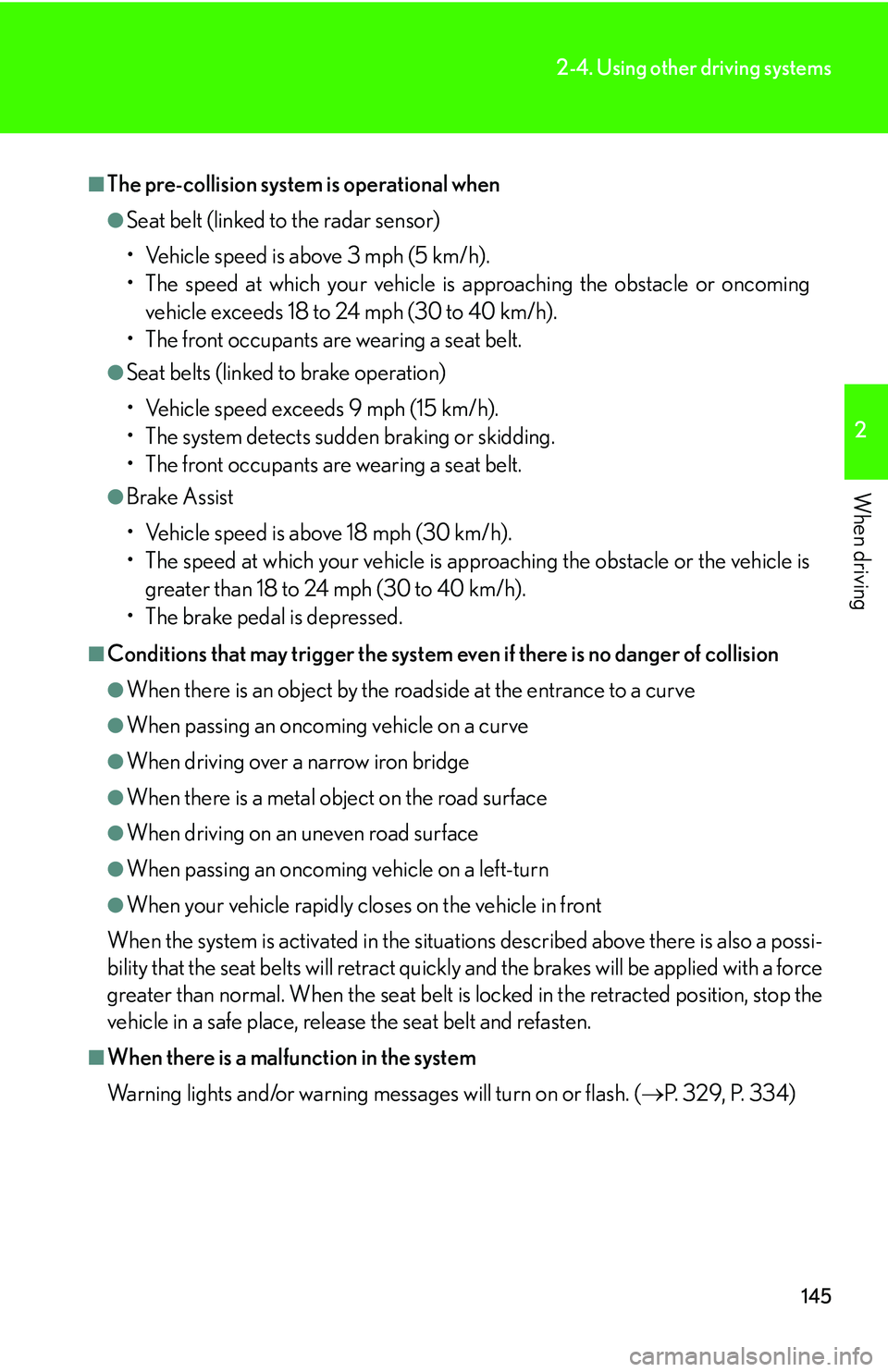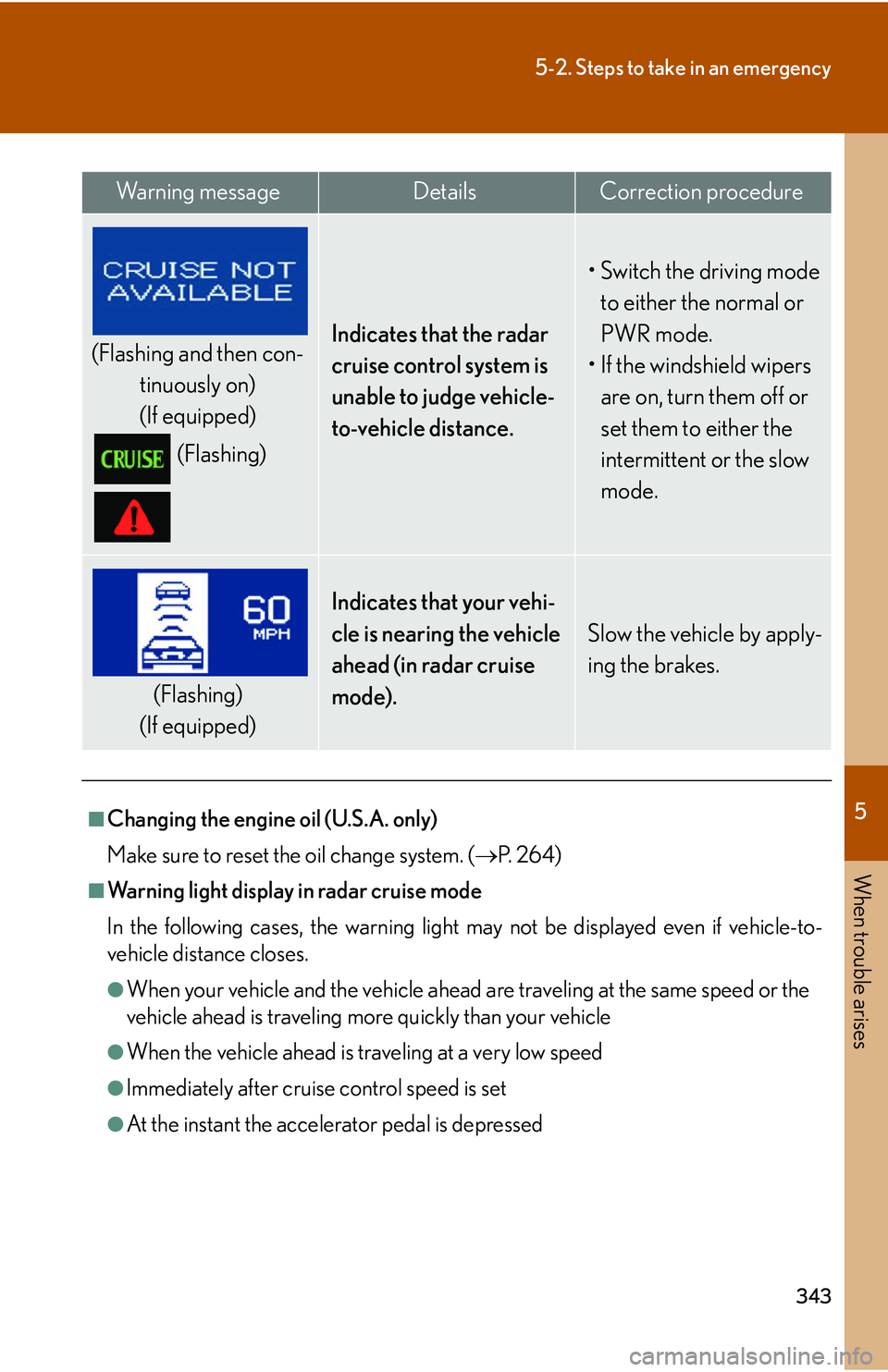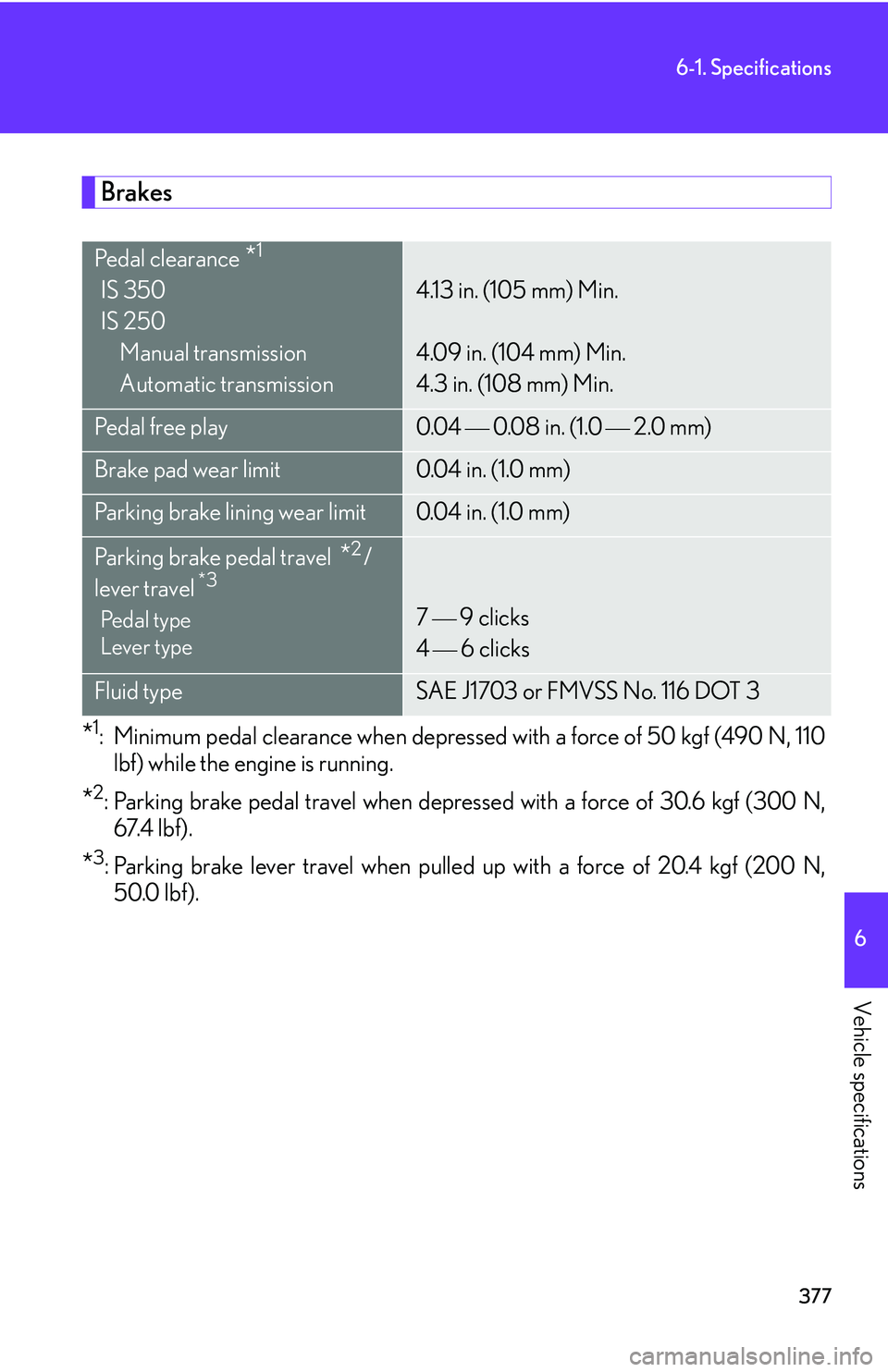brakes Lexus IS250 2006 Using the audio system / LEXUS 2006 IS350/250 THROUGH APRIL 2006 PROD. (OM53508U) User Guide
[x] Cancel search | Manufacturer: LEXUS, Model Year: 2006, Model line: IS250, Model: Lexus IS250 2006Pages: 433, PDF Size: 10.9 MB
Page 162 of 433

144
2-4. Using other driving systems
PCS (Pre-Collision System) (if equipped)
Radar sensorDetects vehicles or other obsta-
cles on or near the road ahead and
determines whether a collision is
imminent based on the position,
speed, and heading of the obsta-
cles. Grille cover
Radar sensor
Safety systems such as the brakes and seat belts are automatically
engaged to lessen impact and injuries to occupants as well as vehicle dam-
age when the radar sensor detects an unavoidable frontal collision.
■Pre-collision seat belts
The seat belts are immediately retracted as the effect of the pretensioner is
increased ( P. 31), to provide even greater constraining force to protect
the driver and passengers. In the event of sudden braking or skidding, the
system will operate even if no obstacle has been detected.
■Pre-collision brake assist
Applies greater braking force in relati on to how strongly the brake pedal is
depressed.
■Obstacles not detected
The sensor cannot detect plastic obstacles such as pylons. There may also be occa-
sions when the sensor cannot detect pedestrians, animals, bicycles, motorcycles,
trees, or snowdrifts.
Page 163 of 433

145
2-4. Using other driving systems
2
When driving
■The pre-collision system is operational when
●Seat belt (linked to the radar sensor)
• Vehicle speed is above 3 mph (5 km/h).
• The speed at which your vehicle is approaching the obstacle or oncomingvehicle exceeds 18 to 24 mph (30 to 40 km/h).
• The front occupants are wearing a seat belt.
●Seat belts (linked to brake operation)
• Vehicle speed exceeds 9 mph (15 km/h).
• The system detects sudd en braking or skidding.
• The front occupants are wearing a seat belt.
●Brake Assist
• Vehicle speed is above 18 mph (30 km/h).
• The speed at which your vehicle is approaching the obstacle or the vehicle is greater than 18 to 24 mph (30 to 40 km/h).
• The brake pedal is depressed.
■Conditions that may trigger the system even if there is no danger of collision
●When there is an object by the roadside at the entrance to a curve
●When passing an oncoming vehicle on a curve
●When driving over a narrow iron bridge
●When there is a metal object on the road surface
●When driving on an uneven road surface
●When passing an oncoming vehicle on a left-turn
●When your vehicle rapidly closes on the vehicle in front
When the system is activated in the situations described above there is also a possi-
bility that the seat belts will retract quickly and the brakes will be applied with a force
greater than normal. When the seat belt is locked in the retracted position, stop the
vehicle in a safe place, release the seat belt and refasten.
■When there is a malfunction in the system
Warning lights and/or warning mess ages will turn on or flash. (P. 3 2 9 , P. 3 3 4 )
Page 170 of 433

152
2-5. Driving information
■Before driving the vehicle
Perform the following according to the driving conditions.
● Do not try to forcibly open a w indow or move a wiper that is fro-
zen. Pour warm water over the frozen area to melt the ice. Wipe
away the water immediately to prevent it from freezing.
● To ensure proper operation of the climate control system fan,
remove any snow that has accumu lated on the air inlet vents in
front of the windshield.
● Remove any ice that has accumul ated on the vehicle chassis.
● Periodically check for and remove any excess ice or snow that
may have accumulated in the wheel well or on the brakes.
■ When driving the vehicle
Accelerate the vehicle slowly and drive at a reduced speed suitable to
road conditions.
■When parking the vehicle
Park the vehicle and move the shift lever to P (automatic transmis-
sion) or R (manual transmission) without setting the parking brake.
The parking brake may freeze up, preventing it from being released.
Page 270 of 433

252
4-2. Maintenance
Vehicle interior
ItemsCheck points
Accelerator pedal• Moves smoothly (without uneven pedal effort or catching)?
Automatic transmission “Park”
mechanism• Can the vehicle be hold securely on an incline with the shift lever in
P?
Brake pedal
• Moves smoothly?
• Does it have appropriate clearance and correct amount of free play?
Brakes
• Not pull to one side when applied?
• Loss of brake effectiveness?
• Spongy feeling brake pedal?
• Pedal almost touches floor?
Head restraints• Move smoothly and lock securely?
Indicators/buzzers• Function properly?
Lights
• Do all the lights come on?
• Headlights aimed correctly? ( P. 3 0 9 )
Pa r k i n g b r a ke
• Moves smoothly?
• Can hold the vehicle securely on
an incline?
Seat belts
• Does the seat belt system operate smoothly?
• Are the belts undamaged?
Seats• Do the seat controls operate prop- erly?
Page 336 of 433

318
5-1. Essential information
If your vehicle needs to be towed
Before towingThe following may indicate a problem with your transmission. Contact
your Lexus dealer before towing.
● The engine is running, but the vehicle will not move.
● The vehicle makes an abnormal sound.
Emergency towing
If a tow truck is not available, in an emergency your vehicle may be tem-
porarily towed using a cable or chain secured to the emergency towing
eyelet(s). This should only attempted on hard, surfaced roads for short
distances at low speeds.
A driver must be in the vehicle to s teer and operate the brakes. The vehi-
cle’s wheels, drive train, axles, steering and brakes must be in good condi-
tion.
Towing eyelets
If towing is necessary, we recommend having your vehicle towed by your
Lexus dealer or a commercial towing se rvice, using a lift-type truck or a flat
bed truck.
Use a safety chain system for all towi ng, and abide by all state/provincial
and local laws.
If towing from the rear, the vehicle’s front wheels and axles must be in good
condition. ( P. 322)
If they are damaged, use a to wing dolly or flat bed truck.
Page 337 of 433

5
When trouble arises
319
5-1. Essential information
■Emergency towing procedureRelease the parking brake.
Put the transmission in N.
Put the engine switch in the ACC mode (engine off) or the IG-ON mode
(engine running).
CAUTION
■Caution while towing
●Use extreme caution when towing the vehicle.
Avoid sudden starts or erratic driving maneuvers which place excessive stress on
the emergency towing eyelets and the cables or chains.
●If the engine is not running, the power assi st for the brakes and steering will not
function, making steering and braking more difficult.
NOTICE
■To prevent causing serious damage to the transmission
(for vehicles with an automatic transmission)
Never tow this vehicle from the front with the rear wheels on the ground.
This may cause serious dama ge to the transmission.
■When towing a vehicle without using a towing dolly
(for vehicles with a manual transmission)
The engine switch must not be OFF.
STEP1
STEP2
STEP3
Page 361 of 433

5
When trouble arises
343
5-2. Steps to take in an emergency
Wa r n i n g m e s s a g eDetailsCorrection procedure
(Flashing and then con-tinuously on)
(If equipped)
(Flashing)Indicates that the radar
cruise control system is
unable to judge vehicle-
to-vehicle distance.
• Switch the driving mode to either the normal or
PWR mode.
• If the windshield wipers are on, turn them off or
set them to either the
intermittent or the slow
mode.
(Flashing)
(If equipped)
Indicates that your vehi-
cle is nearing the vehicle
ahead (in radar cruise
mode).
Slow the vehicle by apply-
ing the brakes.
■Changing the engine oil (U.S.A. only)
Make sure to reset the oil change system. ( P. 2 6 4 )
■Warning light display in radar cruise mode
In the following cases, the warning light may not be displayed even if vehicle-to-
vehicle distance closes.
●When your vehicle and the vehicle ahead are traveling at the same speed or the
vehicle ahead is traveling more quickly than your vehicle
●When the vehicle ahead is traveling at a very low speed
●Immediately after cruise control speed is set
●At the instant the accelerator pedal is depressed
Page 365 of 433

5
When trouble arises
347
5-2. Steps to take in an emergency
InteriorbuzzerExterior buzzerWa r n i n g m e s s a g eDetailsCorrection
procedure
Once
(For vehicles with an
automatic transmission)
Indicates that a
door has been
opened or closed
and the engine
switch has been
switched twice to
ACC mode from
OFF.
Press the engine
switch while
applying the
brakes.
Once
(For vehicles with a
manual transmission)
Indicates that a
door has been
opened or closed
and the engine
switch has been
switched twice to
ACC mode from
OFF.
Press the engine
switch while
depressing the
clutch pedal.
Once
(Flashing)
Indicates that the
steering lock has
not released
within 3 seconds
of pressing the
engine switch.Press the engine
switch again while
turning the steer-
ing wheel with the
brake pedal
depressed.
Page 378 of 433

360
5-2. Steps to take in an emergency
Starting the engineFor vehicles with an automatic tr ansmission: Put the shift lever in P
and apply the brakes.
For vehicles with a manual transmission: Depress the clutch
pedal.
Hold the electronic key close to
the engine switch (within 0.4 in.
[10 mm]). Make sure that the but-
ton side of the key is facing away
from the engine switch.
An alarm will sound to indicate that
the start function cannot detect the
key with the depleted battery if any
of the doors will be opened and
closed while this operation.
For vehicles with an automati c transmission: Press the engine
switch within 5 seconds [after the buzzer sounds], keeping the
brake pedal depressed.
For vehicles with a manual tra nsmission: Press the engine switch
within 5 seconds [after the buzzer sounds], keeping the clutch
pedal depressed.
In the event that the engine still cannot be started, contact your Lexus
dealer.
STEP1
STEP2
STEP3
Page 395 of 433

377
6-1. Specifications
6
Vehicle specifications
Brakes
*1: Minimum pedal clearance when depressed with a force of 50 kgf (490 N, 110lbf) while the engine is running.
*2: Parking brake pedal travel when depressed with a force of 30.6 kgf (300 N,67.4 lbf).
*3: Parking brake lever travel when pulled up with a force of 20.4 kgf (200 N,50.0 lbf).
Pe d a l c l e a r a n c e *1
IS 350
IS 250
Manual transmission
Automatic transmission4.13 in. (105 mm) Min.
4.09 in. (104 mm) Min.
4.3 in. (108 mm) Min.
Pedal free play0.04 0.08 in. (1.0 2.0 mm)
Brake pad wear limit0.04 in. (1.0 mm)
Parking brake lining wear limit0.04 in. (1.0 mm)
Parking brake pedal travel *2/
lever travel *3
Pe d a l t y p e
Lever type7 9 clicks
4
6 clicks
Fluid typeSAE J1703 or FMVSS No. 116 DOT 3